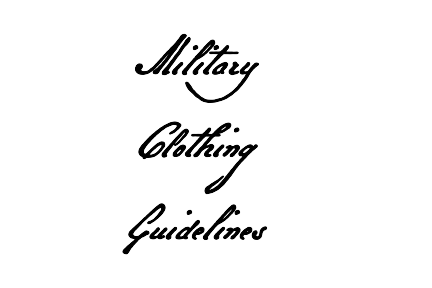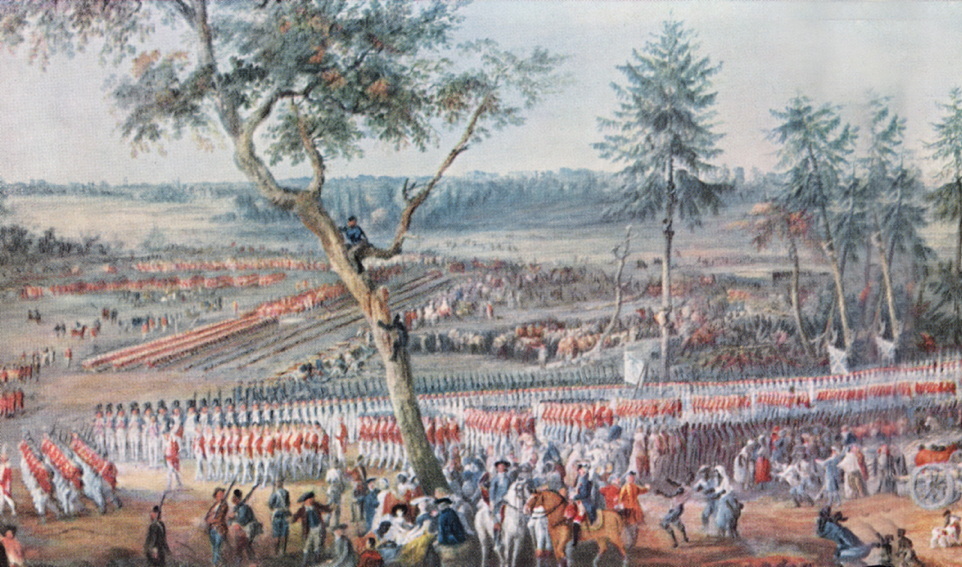
The Crown Forces of 1781 had been at war in North America for over six years. In that time the British and its allies experimented with several attempts at adapting their clothing to local conditions, from the un-laced coats of the Guards on arrival in North America, and the docked coats and cut-down caps of the Saratoga Campaign, to the round jackets and round hats of the Philadelphia Campaign. As soon as the British army arrived in North America they also almost universally adopted linen breeches and short gaiters as a temperate weather replacement for the woolen breeches and full gaiters of the 1768 Warrant. However, as early as the Summer of 1777 these had given way to the signature garment of service in North America; the trowser.
By August of 1781 the British Army had settled on a generally standard appearence of a cocked hat or cap of some kind - (bearskin caps typically being left in storage), full length regimental coat, woolen waistcoat (although some units had linen waistcoats), and trowsers. The bayonet belt had long since been moved from around the waist to over the shoulder, and knapsacks were frequently set aside in preference to a blanket roll.
Great Britain's Gemanic allies had also made some accomodation to service in the Southern Campaign, mostly by exchanging their woolen breeches and high gaiters for linen or ticking trowsers
For Before the Siege, we want to encourage you and your unit to try for as close to a late war Southern Campaign apperance as you can manage.

This detail from Louis-Nicholas van Blarenberghe's "Yorktown Surrender" shows the appearance of the British Army at Yorktown.
The Before the Siege: The Royal Navy in Yorktown event flyer has clothing guidelines for the ad hoc crew of HMS CHARON. For more information please visit the: The Royal Navy in Yorktown Facebook page.
Preferred
Preferred
A cocked hat; hat body made from wool or fur felt, blocked on a round block, with leaves, gutters, ties, and trim according to your unit's specifications; all hand sewn with natural materials such as linen or silk thread, ties made of wool, mohair, linen, or silk, linen or leather lining, binding (if any) of wool, mohair, linen, or silk, cockade of silk, linen, or horsehair, wool or linen hat cord, and all metallic trim (if any) done with real metal lace, cord, or braid - not coated mylar.
A cap appropriate to your unit's specifications. If a felt cap or cut down cocked hat it should be made using construction and materials as stated above, if a bonnet it should be woven, blocked, and fulled as one piece, the dicing should not be plaited strips of braid.
A regimental coat, made of no less than 23 ounce per yard well fulled 100% wool (Other Ranks, officers may vary) - madder red for British Army enlisted soldiers, scarlet for Serjeants and officers, other colors as appropriate for your unit. The coat should be fitted but not excessivly constrictive; the cape and neckline should not fall below the collar bone, the sleeves should be cut to the bend of the arm and not be baggy, the coat skirts should end at least four inches above the knee. The shoulder seams should come behind the shoulder, the cuffs should have two seams, the lace at the rear vent should come no higher than to bisect a line across the side vent buttons. The edges of the cape, lappels, cuffs, and skirts should be cut raw. The outermost edge of each lacing loop should be no more than 3/16th inch from the nearest raw edge. British Corporals should have a white silk epaulette. British Serjeants should have a sprang woven sash. The coat should be completely hand sewn with linen or silk thread matched to the color of the wool.
A shirt, hand sewn, of 8 to 10 ounce per yard white linen, made to a third quarter of the 18th Century pattern; with cuff bands no wider than one inch. The collar should be fitted to lie smoothly around the neck when buttoned, the shirt body should come down to mid-thigh. The neck fastened with thread buttons, the cuffs fastened with thread buttons, thread sleeve links, or metal sleeve links. Shirts may also be made of checked linen; blue and white checks no more than 1/4 inch in size. Checked shirts may be worn as shirts or over the waistcoats as a work smock.
Neckstock; hand sewn of black horsehair, black leather, white linen, or silk velvet as appropriate for your unit or rank. Horsehair neckstocks should be made with the stiff grain of the hair running vertically, not horizontally. Neckstocks may be fastened with ties, clasps, or buckles. They should fit snugly around the neck, with no gap. Linen rollers may also be worn if documented to your unit
A waistcoat, made of no less than 23 ounce per yard well fulled wool (Other Ranks, officers may vary). Unless it is square cut it should be long enough that the skirts cover bottom point of the breeches plaquet or trowser fall opening. The neckline of the waistcoat should come no lower than the collarbone. It should fit snugly without being constrictive. It should be hand sewn with linen or silk thread matched to the color of the wool. The edges of the neckline, armscye, front, and skirt edges to be left raw. Pockets, flaps, trim, and ornamentation according to documentation for your unit.
Trowsers (gaitered); made of linen or hemp twill, drill, ticking or other sturdy linen or hemp fabric. Well fitted through the thighs, knees and ankles. Hand sewn with linen or silk thread.
Shoes; straight last round toe (other toe shape per your unit documentation) well polished flesh side out black leather for Other Ranks, other finishes for officers or per your unit documentation. Hand sewn with butted and round closed seams on vamps and heels. Hobnails or metal heel rims on heels only.
Accoutrements, straps, slings &c. representing whitened or colored buff leather should be made of whitened or colored buff leather. All stitching by hand with linen thread with lift and split stitching where appropriate.
Clean shaven (no more than three day's growth), unless specifically documented to your unit. At least eighteen inches of hair from the nape of the neck down the back, clubbed, plaited, tied, queued, or as per the documentation for your unit.
Acceptable
Acceptable
Cocked hat with concealed machine stitching. Blocked on an oval block. Mylar based metallic trim. Cotton hat cord.
Cap with concealed machine stitching. Mylar based metallic trim.
Regimental coat made of no less than 21 ounce per yard wool/nylon blend. Sewn with concealed machine stitching - all visible stitching, lace and trim done by hand. British Corporals with a white wool epaulette. British Serjeants with a pieced woolen braid sash. Mylar based lace or braid on officer's coats.
Shirt sewn with concealed machine stitching.
Neckstock or roller sewn with concealed machine stitiching
Waistcoat made of no less than 21 ounce per yard wool/nylon blend. Sewn with concealed machine stitching - all visible stitching by hand.
Trowsers sewn with concealed machine stitching - all visible stitching by hand. Fitted so that you can pinch no more than one half inch of fabric at the side seam from mid-thigh to the ankle.
Shoes. Crooked last, machine sewn.
Accoutrements, straps, slings, &c. made with white latigo.
From one to three inches of hair at the nape of the neck.
Strongly discouraged
Strongly discouraged
Cocked hats with machine sewn binding. Cocked hats with taller than four inch crown.
Caps with machine sewn binding. Bearskin, Grenadier, Fuslier, Drummer's cap. Leather Light Infantry skull cap with the three chains on the crown.
Regimental coat made with under 18 ounce per yard wool, with turned edges on the capes, cuffs, and lappels. Machine topstitching. Wine red or blood red wool. More than two fingers gap between the neckstock and the top front edge of coat. Sleeves fitted so that you can pinch an inch or more of fabric from bicep to cuff along the arm outer seam. Sleeves longer than 1 1/2 inches from the wrist bone. Skirts within three inches of the ground when kneeling. Lace loops above a line between the side vent buttons. Lace loops more than 1/4 inch from the nearest raw edge. Lace loops shorter than 2 3/8 inches overall. Wool Corporal's knot. Shoulder wings which extend more than three inches below the shoulder seam.
Shirt sewn with all machine stitching. Shirt collar that extends more than 1 1/2 inches over the neckstock when folded over. Shirt collar that allows two fingers of room at the neck when buttoned. Shirt cuffs wider than one inch.
Neckstocks made with the stiff grain of the hair running circumfrentially. Neckstocks made of limp black fabric.
Waistcoat made with under 18 ounce per yard wool, with turned edges. Machine topstitching and buttonholes. Short enough to expose entire breeches waistband and show the shirt. Longer than four inches below the bottom of the coat lappel. More than two fingers gap from the neckstock to the top front of the waistcoat. Fitted so that you can pinch no more than two inches of fabric at the side seam.
Straight leg trowsers - unless you are a Marine. Machine sewn trowsers. Fitted so that you can pinch an inch or more of fabric at the side seam from mid-thigh to the ankle. Trowsers that are too long.
Blücher boots. ACW brogans.
Bayonets worn around the waist. 1 1/2 inch wide black metal sling swivels on a Short Land Pattern Musket. Haversacks worn with the Broad Arrow on the outside. Wool covered tin canteens.
Less than one inch of hair at the nape of the neck. Units should have a uniform hairstyle. Mixing of clubbed hair and buzz cut or shaved heads is strongly discouraged.
Not Acceptable
Not Acceptable
Unfinished hat blank worn as a “hat”.
Regimental coat made from twill or canvas. Coats using cotton or poly/cotton tape for lace. Coats fitted with a three finger or more gap from the neckstock to the top front edge of the coat. Sleeves fitted so that you can pinch two inches or more of fabric from bicep to cuff along the arm outer seam. Sleeves longer than 2 inches from the wrist bone. Skirts within one inch of the ground when kneeling.
Shirts made of muslin. Colored shirts. 19th Century shirts - wide cuffs, collars that don't lap over each other.
No neckwear. A neckstock, kerchief, or roller must be worn even under heavy labor.
Waistcoat made of canvas or twill. More than three fingers gap from the neckstock to the top front of the waistcoat. Fitted so that you can pinch more than two inches of fabric at the side seam.
Breeches and long gaiters. Breeches and short gaiters (Officers excepted). Canvas trowsers. Trowsers fitted so that you can pinch more than an inch of fabric at the side seam from mid-thigh to the ankle. Trowsers that are too long and have baggy ankles.
Modern shoes. Sneakers. Hiking boots. Combat boots. Ammo boots.
The old BAR pettern 36 round cartridge pouch. ACW cartridge pouch with the "US" taken off. White canvas haversack.
Facial hair unless specifically documented for your unit.
